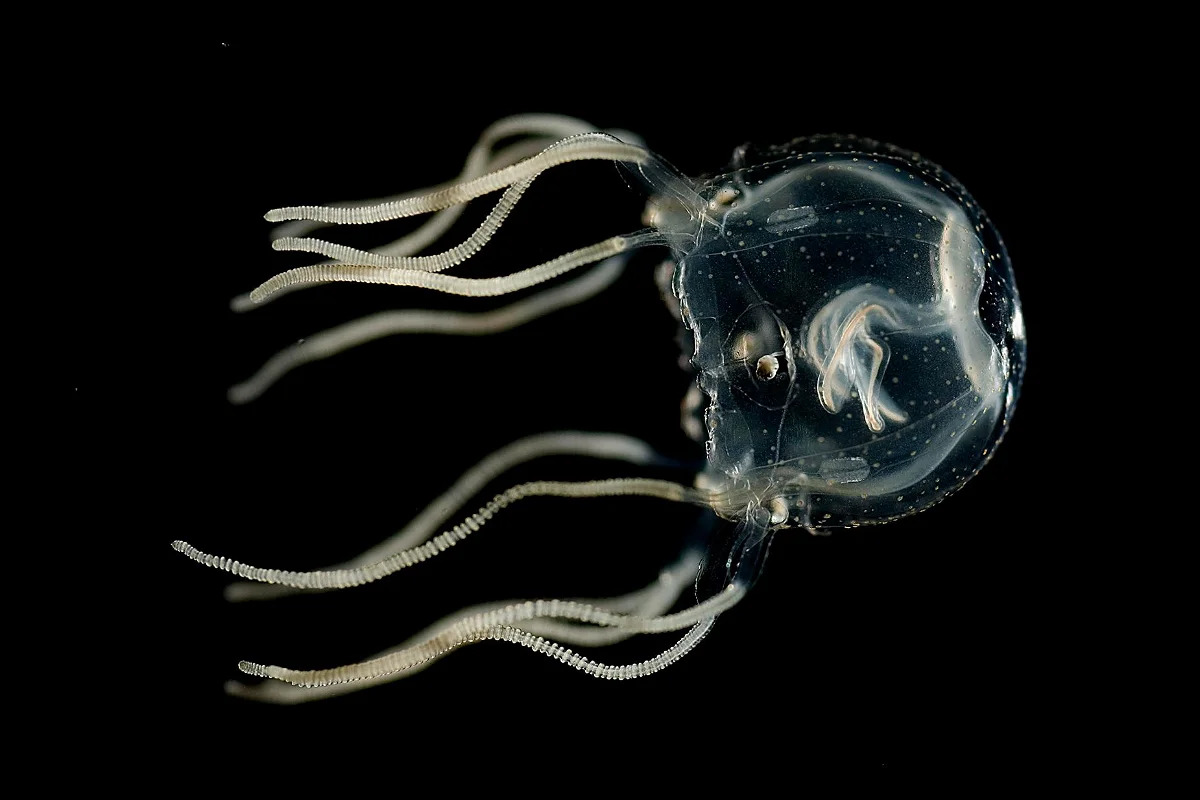Jellyfish. I think of them as these cute blob-like creatures that passively float across the ocean’s surface. I never would’ve thought that they could think and learn in ways similar to animals with brains, but as it turns out, that’s exactly what they do.
The Caribbean box jellyfish can be found floating among the waters of mangrove forests. It is a translucent, tiny box-shaped creature, measuring only one centimeter in length. The box jellyfish is slightly different from other jellyfish due to its complex visual system—these mini organisms have twenty-four eyes! However, like other jellyfish, this box jellyfish is brainless and instead is controlled by neurons that are spread across its body. These neurons may actually be more complex than just controlling motion like we originally thought.
For the last several years, Jan Bielecki, a postdoctoral researcher at Kiel University in Germany, has been conducting research on jellyfish behavior. After delving into the visual behavior of jellyfish, he decided that the next logical course of study was the animals’ learning behavior. Bielecki teamed up with Anders Garm, a biologist at the University of Copenhagen, and his research team. In early September 2023, the team published a paper describing their findings on the Caribbean box jellyfish’s learning abilities.
To study the learning behavior of the jellyfish, the researchers first found a task that they could train jellyfish to do in a lab that was also somewhat applicable to life for jellyfish in the wild. They chose to line round buckets with dark and light stripes as a way to mimic the dark mangrove roots that occupy the Caribbean waters where these jellies live. The light stripes would represent clear water during broad daylight when the sun was shining. In the wild, collisions into the mangrove roots could be fatal for the jellyfish, so the researchers used the black lines to mimic this stress. The scientists then adjusted the contrast between the dark and light lines and observed the number of collisions the jellyfish would have with the sides of the tanks. When the lines were completely black and white, the jellyfish had no trouble avoiding the walls of the tank, but once the contrast between the stripes was lessened, collisions began to occur.
This was the crucial part of the experiment—if the jellyfish could learn and change their behavior to avoid collisions. After around five minutes of being in this tank, the jellyfish were already swimming further away from the stripes and seemed to have made a connection between the dark stripes and collision. This implies that the jellyfish were able to combine visual stimulation with past experience to quickly learn that there was a connection between the two, therefore allowing them to avoid the obstacle. The researchers then pushed this experiment even further by testing a sample of visual neurons to see if those cells alone were able to learn that dark stripes and collisions have a correlation. Again, with weak electrical stimulation and in just five minutes, the cells were able to send impulses that would cause the jelly to turn around and avoid the stripes.
These experiments showed that Caribbean box jellyfish are able to learn from their surroundings and even seem to have some form of short-term memory, all without the presence of a brain. The research team’s findings have led to even more questions about how organisms actually learn and what the cause of learning is, if not a centralized brain. Scientists can use this knowledge on how brainless creatures learn and apply it to robotics so that robots are able to read patterns, learn, and adapt to their surroundings. Researchers can also learn more about evolution as they seek where the ability to learn actually comes from. These tiny jellies have sparked a huge revolution on what it means for animals to be able to learn.

